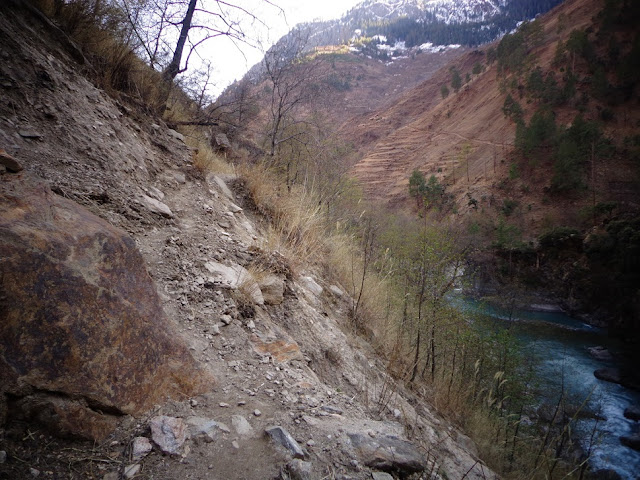The confusion, the question, the purpose and the destination
 |
| A snap before the three day walk |
When I woke up in Lali the following morning, I felt like I could not continue any further. I could count every muscle in my legs to the number of separate and different pains accompanying them. My body ached too, owing to the mattress-less bed, I presumed. Naresh dai was, as I had explained earlier, old, and because of that, was having difficulty walking with all of my luggage glued to his back. I admit that it was apathetic and cruel of me to feel a sense of relief that I was not alone in this difficult endeavor.
We continued with our journey slowly, with an undefeated
enthusiasm, however little in comparison to the day before. The pain in the
muscles lessened after each step. It was almost like my feet were demanding
affliction. We made it to Suniyakhada in one hour, the place we originally
intended to stay the day before. I asked my companion if we would reach the
day’s destination or not. He replied by saying “Khai sir, hidai sasto bhaya
cha”, meaning he wasn’t sure because our pace was not as fast as he hoped
(it was for the first time in my life that the word “sasto” which means "Cheap" in Nepali bore a
negative meaning).
As we moved on, the pain in my muscles and my knees
oscillated like a sine-wave – it would come and go in regular successions, the
only difference being its magnitude, which increased with each new succession.
We limped our way to “Lepche”, where we decided to have lunch. Now I had one or
two strange incidences relating to the language of the west, and one of them
happened here. I was having my regular daal bhaat, with about a quarter
of the food remaining in my plate, when the owner came to me and said, “Bhaat
choda” (The conventional Nepali meaning of the word would mean stop eating your rice). I was puzzled, as to why he wanted me to leave my meal unfinished.
I looked at Naresh dai and found him munching away merrily. I didn’t know what
to do, so I thought about getting up, seeking the reaction that would follow. Just
as I was about to, Naresh dai with his stuffy voice said to the owner, “Bhaat
choda”. Hearing this, the owner obediently went to the kitchen and put some
rice in Naresh dai’s plate. Then, he looked at me and asked, “Bhat choda?”
I smiled and said no.
We left Lepche after an hour long rest, and I was delighted
when Naresh dai informed me that the trail was very comfortable then on. And it
was. We walked slowly without hurry, and Naresh dai shared with me things about
Humla and about his life. We were about an hour away from Sarkeghat, our
destination for the day when we decided to take a break.
 |
| A dangerous section of the trail |
 |
| I would be lying if i said my feet didn't tremble when i walked through this place |
Our breaks would always be short and without conversation. I
was staring into the abyss when he asked me suddenly in his Nepali-Khasa hybrid
language why I had undertaken a job in Humla where I had to toil so hard, that
too, unnecessarily. This was the first time he asked me something personal, and
I looked at him and saw an earnest curiosity in his face. I didn’t know what to
say to him because I wasn’t completely convinced myself why I was there. I
confessed that I wasn’t pretty much sure myself too, and told him that part of
me wanted to see real adversity and experience it firsthand. I knew that it was
not the real reason. Six months later and I still can’t fathom any reason,
except that whatever the reason was, I had made a good choice.
We reached Sarkeghat at 5:30 pm. Sarkeghat was beautiful, in
that it had good hotels with clean sheets, good food, electricity and TVs as
well. Another interesting thing about the place was that the people there
actually spoke an accent-less Nepali. We had walked for 11 hours and I was
tired to my bone, drenched in sweat and smelly. There were plenty of staff from other
organizations in the hotel I was staying. I wanted to have a chat and hear
their experiences too but I was too tired to indulge in any conversation. So I
had dinner and went straight to bed.
The third and the final day of my walk had been pretty
normal in comparison to the other days. I reached my destination Darma at
around 4 pm. I finally reached my workplace, and it took me only a taxi ride,
two flights and a 25 hour walk to get there from my house. I said my goodbyes
to Naresh dai admitting that I had not expected such a pleasant companionship
from a porter. He corrected me by saying that he was a mason, not a porter, grinned
and left.
 |
| Darma Village- The work station |
It has already been five months since my first travel
through that wretched trail, and I had the unfortunate opportunities to walk
through it many times. But I believe that my first work-walk will always be
memorable because it had a tinge of thrill, curiosity, hesitancy and pain in it
that I will never forget. I remember Naresh dai’s question about my reason, and
well, I want to believe that there isn’t one. I went to Humla just for the sake
of being there. But I think it’s the eventuality of the action that carries the
essence of justification and in my case, it is undoubtedly justified.
 |





